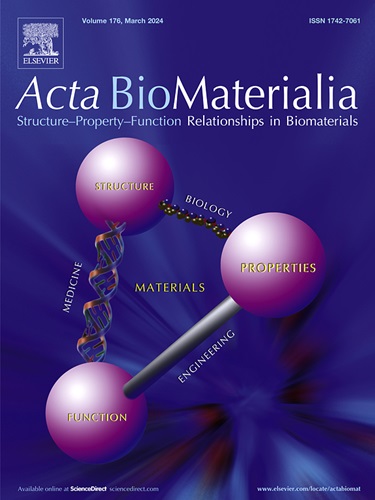易聚集的抗菌肽靶向革兰氏阴性细菌的核酸和蛋白质合成。
IF 9.4
1区 医学
Q1 ENGINEERING, BIOMEDICAL
引用次数: 0
摘要
抗菌肽(AMPs)的聚集通过破坏细菌细胞壁、膜和细胞质蛋白的稳定性来增强其功效。开发易于聚集的抗菌肽为对抗抗生素耐药性提供了一个有希望的策略,尽管预测这种抗菌肽和理解细菌反应仍然具有挑战性。章鱼是一种头足类动物,缺乏已知的AMP基因家族,但其蛋白质片段通过人工智能工具用于预测AMP。四种肽(Oct-P1, Oct-P2, Oct-P3和Oct-P4)根据它们的聚集倾向被鉴定出来。其中Oct-P2通过共聚焦激光扫描显微镜和扫描电镜证实,可使大肠杆菌和金黄色葡萄球菌的生存能力降低高达90%。它在体外进一步聚集质粒DNA,细胞外DNA的存在降低了它们的抗菌活性。对于敲除突变体,研究表明Oct-P2可能通过膜转运蛋白被内化到细菌细胞中,从而增强了其抗菌作用。聚集诱导发射实验和分子动力学模拟表明Oct-P2与转录启动子DNA聚集,抑制转录和翻译。这种双靶点机制不仅突出了Oct-P2作为新型抗菌药物开发先导模板的潜力,而且为从蛋白质片段中发现抗细菌感染的抗菌肽打开了一扇新的窗口。意义声明:在特定基因组中鉴定抗菌肽(AMP)的流行策略使用AMP家族的保守区域,但该策略在缺乏经典AMP基因家族的生物体中存在局限性,例如章鱼。非抗菌蛋白片段为鉴定新的抗菌蛋白提供了丰富的来源。在这项研究中,我们使用人工智能工具从章鱼的非抗菌蛋白中寻找潜在的候选AMP序列。成功鉴定易聚集的amp被证明会降低细菌活力,增加渗透性,减少生物量。其中一种候选药物Oct-P2通过与DNA聚集并抑制转录和翻译来杀死革兰氏阴性细菌大肠杆菌,这表明AMP活性的一种新的细胞内机制。本文章由计算机程序翻译,如有差异,请以英文原文为准。

Aggregation-prone antimicrobial peptides target gram-negative bacterial nucleic acids and protein synthesis
Aggregation of antimicrobial peptides (AMPs) enhances their efficacy by destabilising the bacterial cell wall, membrane, and cytosolic proteins. Developing aggregation-prone AMPs offers a promising strategy to combat antibiotic resistance, though predicting such AMPs and understanding bacterial responses remain challenging. Octopus bimaculoides, a cephalopod species, lacks known AMP gene families, yet its protein fragments were used to predict AMPs via artificial intelligence tools. Four peptides (Oct-P1, Oct-P2, Oct-P3, and Oct-P4) were identified based on their aggregation propensity. Among them, Oct-P2 reduced the viability of Escherichia coli and Staphylococcus aureus by up to 90 %, confirmed by confocal laser scanning microscopy and scanning electron microscopy. It further aggregated plasmid DNA in vitro, and the presence of extracellular DNA reduced their antibacterial activity. With knockout mutants, it revealed that Oct-P2 was internalized into bacterial cells, possibly through membrane transport proteins, enhancing its antibacterial effect. Aggregation-induced emission assays and molecular dynamics simulations revealed that Oct-P2 aggregates with transcription promoter DNA, inhibiting transcription and translation in vitro. This dual-target mechanism not only highlights the potential of Oct-P2 as a lead template for new antimicrobial drug development, but also opens a new window for discovering AMPs from protein fragments against the upcoming challenge of bacterial infections.
Statement of significance
A popular strategy for identifying antimicrobial peptides (AMPs) in specific genomes uses the conserved regions of AMP families, but this strategy has limitations in organisms lacking classical AMP gene families, such as Octopus. Fragments from non-antimicrobial proteins serve as a rich source for the identification of new AMPs. In this study, we used artificial intelligence tools to search for potential candidate AMP sequences from non-antimicrobial proteins in Octopus bimaculoides. The successful identification of aggregation-prone AMPs was shown to decrease bacterial viability, increase permeability, and reduce biomass. One candidate, Oct-P2, kills the gram-negative bacteria E. coli by aggregating with DNA and inhibiting transcription and translation, suggesting a new intracellular mechanism of AMP activity.
求助全文
通过发布文献求助,成功后即可免费获取论文全文。
去求助
来源期刊

Acta Biomaterialia
工程技术-材料科学:生物材料
CiteScore
16.80
自引率
3.10%
发文量
776
审稿时长
30 days
期刊介绍:
Acta Biomaterialia is a monthly peer-reviewed scientific journal published by Elsevier. The journal was established in January 2005. The editor-in-chief is W.R. Wagner (University of Pittsburgh). The journal covers research in biomaterials science, including the interrelationship of biomaterial structure and function from macroscale to nanoscale. Topical coverage includes biomedical and biocompatible materials.
 求助内容:
求助内容: 应助结果提醒方式:
应助结果提醒方式:


